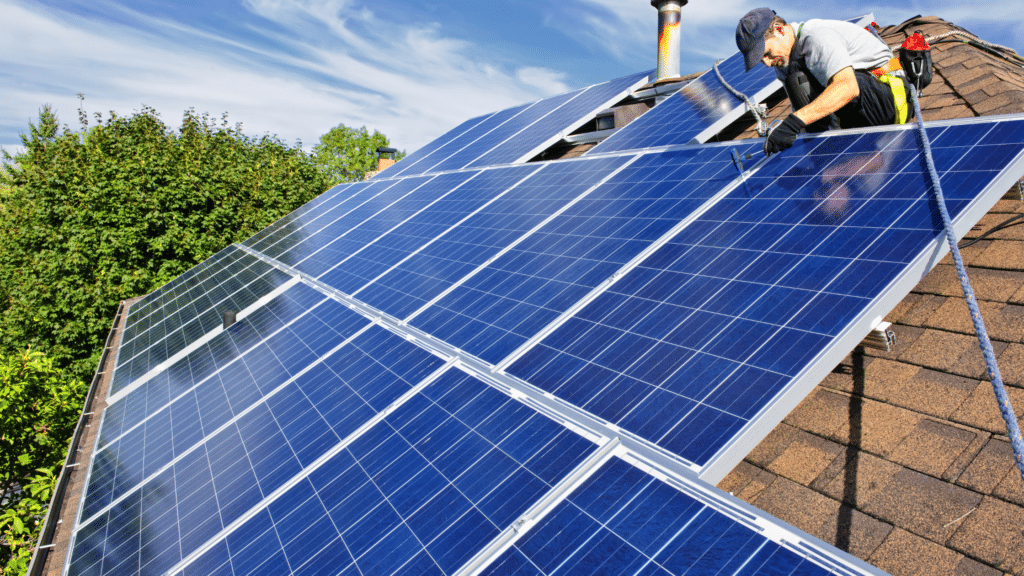How Do Solar PPAs Work?
A solar PPA is similar to a solar lease, but the two agreements differ in what you pay for. Under a solar lease, you pay a fixed monthly fee to use a solar energy system. But with a PPA, a solar system provider charges you for the electricity generated each month instead of a fixed payment. Here’s an example of how a lease and PPA would differ:
- Solar panels are more productive during summer due to the increased sunshine hours and less productive during winter.
- For this reason, PPA payments tend to be higher in summer and lower in winter.
- On the other hand, a solar lease charges you fixed payments all year long so rates would not fluctuate based on sunlight hours.
When you sign a PPA, the solar provider assumes all upfront costs, including equipment purchases, labor costs and permitting. The provider is also responsible for keeping the solar photovoltaic (PV) system operational, meaning the company also assumes maintenance costs. In exchange, you agree to buy all the electricity generated during the contract term. To make the deal attractive for you, the agreement’s kilowatt-hour (kWh) price is set below local electricity rates.
A PPA contract has many terms and conditions, which include:
- Energy pricing: The electricity price set by a solar PPA is typically lower than local electric tariffs, making the deal attractive for homeowners.
- Escalator clause: Some PPA contracts gradually increase the kilowatt-hour price over time, while others agreements have a fixed rate during the entire term.
Benefits of Solar PPAs
When you own solar panels directly, you keep all the savings and incentives achieved by the system. On the other hand, a solar PPA splits the financial benefits between the system provider and the homeowner.
Major benefits for the homeowner or PPA user include:
- You can purchase clean electricity at a price lower than local tariffs
- Solar panels lower your home’s carbon footprint
- You delegate solar system maintenance to an experienced company
- Guaranteed utility bill savings for up to 25 years
On the other hand, some benefits for the solar system provider are:
- Having a client purchase energy through a long-term contract
- Can claim solar tax incentives and rebates
- Some states allow PPA developers to earn additional income from Solar Renewable Energy Credits (SRECs)
- Earning revenue from solar projects distributed across many homes and businesses
Financial incentives like the solar Investment Tax Credit (ITC) are only available to the legal owner of a renewable energy system. So while you can claim solar tax credits when purchasing a system directly with cash or a loan, incentives go to the system provider when you sign a PPA or lease.
Many states have net metering programs that allow you to sell excess solar electricity to the local utility company for billing credits. Generally, solar PV systems installed through a lease or PPA are eligible to participate in net metering.
Implications and Impact of Solar PPAs
Solar PPAs make clean energy accessible to a larger number of homes. Before financial incentives, you can expect to spend between $15,000 to $20,000 to purchase a solar energy system. Loan financing is also an option, but you typically need a high credit score to access low-interest rates. A solar PPA typically has less demanding conditions than a solar loan, which means more customers can potentially qualify.
Solar loans and PPAs increase access to solar energy, helping reduce the residential sector’s carbon footprint. Fossil fuels still dominate the U.S. power sector, but the energy generated by solar panels can offset carbon dioxide (CO2) emissions from grid sources. The U.S. Energy Information Administration (EIA) estimates the emissions associated with fossil fuel generation as follows:
- Coal: 2.26 pounds of CO2 per kWh
- Natural gas: 0.97 pounds of CO2 per kWh
- Petroleum: 2.44 pounds of CO2 per kWh
So for example, assume you purchase 10,000 kWh of electricity a year through a solar PPA. If the local grid depends on gas-fired power plants, you could avoid 970 pounds of annual emissions while lowering your monthly energy costs.
Regardless of how you pay for a solar PV system, you will see clean electricity for decades. The best residential solar panels come with a 25-year product warranty, and professional solar installers also offer a workmanship warranty to cover system installation.
Solar PPA vs. Other Financing Options
There are many ways to pay for a solar panel installation, including a cash purchase, loan or lease. The following sections discuss how a solar PPA compares with other financing options.
Solar PPA vs. Cash Purchase
Purchasing a solar PV system in cash will yield the highest savings in the long run since you own the system immediately, but this option is not attainable for everyone. Considering the average home solar system costs $2.85 per watt, you would need around $17,100 to purchase a 6 kilowatt (kW) system upfront. However, unlike a PPA, you can claim the 30% federal tax credit to lower your overall system cost.
By signing a solar PPA, you avoid the upfront cost of purchasing a solar PV system. You also see savings right away since PPAs charge a lower electricity price than the local power company. However, your long-term savings are lower since you will never own the system and cannot claim solar tax incentives.
Solar PPA vs. Solar Loan
Going solar for $0 down is also possible with loan financing. Since loans charge interest, long-term savings are slightly lower than those achieved with a cash purchase. However, you can claim solar tax credits and incentives with a loan since you own the PV system.
Solar loans and PPAs both involve monthly payments over time, but if you qualify for low-interest rates, loan financing is more affordable and results in system ownership.
Solar PPA vs. Solar Lease
As previously mentioned, solar leases and PPAs are very similar. In both cases, the system provider remains as the owner and you pay a monthly fee. The main difference is:
- A solar lease charges a predetermined monthly fee, regardless of energy production.
- A solar PPA charges you a kilowatt-hour price, which means your payment increases or decreases along with productivity.
Generally, solar leases and PPAs yield similar savings in the long run. The advantage of a solar PPA is paying less during winter months when your solar panels are less productive. You will likely pay more during summer, but your energy bill savings are also higher.
You cannot claim tax credits and certain solar incentives if you choose a lease or PPA, but can still participate in net metering programs.
The Bottom Line: Are Solar PPAs Worth It?
Choosing a solar PPA is ultimately up to you and your solar goals. A solar PPA is a financing agreement in which a solar provider installs a system on your property and charges you for the energy generated. With a PPA, you can go solar at zero upfront cost and see immediate electric bill savings. Your solar provider is also responsible for maintaining the system during the entire contract term — your only responsibility is paying for the electricity generated.
But PPA agreements also have disadvantages. Since you don’t own the solar energy system, you cannot claim the federal solar tax credit and other incentives. Solar PPAs charge an electricity price below local rates, but you don’t save the full value of each kilowatt-hour. In other words, you are sharing your savings with the PPA provider.
A solar PPA makes sense if you want to avoid the upfront cost of purchasing a home solar system or don’t have access to low-interest loans. But both cash purchases and loans offer higher savings than a PPA in the long run since you own the system and can claim solar incentives.
For example, solar panels can increase the market value of your home, and many states exempt this added value from your property taxes. But your home value remains the same if a provider installs panels through a lease or PPA since the company owns the system.
Reputable solar companies offer several purchasing options, including PPAs. Regardless of the buying option you choose, your provider will make sure your solar energy system is properly sized based on your energy usage and budget.
Leonardo David is an electromechanical engineer, MBA, energy consultant and technical writer. His energy-efficiency and solar consulting experience covers sectors including banking, textile manufacturing, plastics processing, pharmaceutics, education, food processing, real estate and retail. He has also been writing articles about energy and engineering topics since 2015.
Tori Addison is an editor who has worked in the digital marketing industry for over five years. Her experience includes communications and marketing work in the nonprofit, governmental and academic sectors. A journalist by trade, she started her career covering politics and news in New York’s Hudson Valley. Her work included coverage of local and state budgets, federal financial regulations and health care legislation.
Read the full article here









